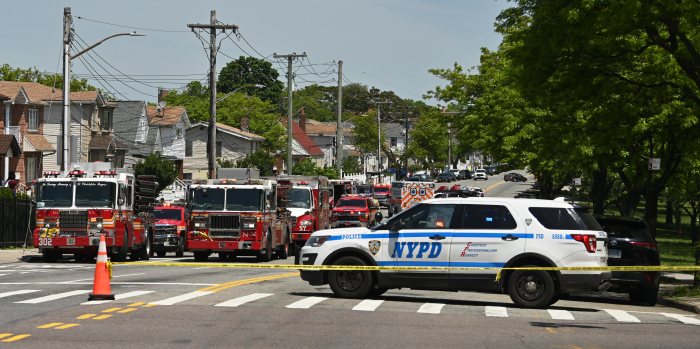By Julie Shapiro
Every time Jeff Galloway tells someone about the plight of Gateway Plaza tenants, he realizes that he has to back up and start by explaining the building’s unique rent protections.
Gateway’s current rent agreement expires in 2009, and Galloway is one of the tenants leading the fight to keep the building affordable. Unlike government-run rent-stabilization programs, all incoming tenants at Gateway pay market-rate rent, but their renewal increases are regulated.
Galloway launched into his explanation at the Community Board 1 Battery Park City Committee Monday night and fielded a series of questions from committee members and residents. After an hour-long discussion, several attendees said they understood Gateway’s rent structure for the first time.
Maria Smith, a Battery Park City resident and former chairperson of the B.P.C. committee, told the committee that there are many misunderstandings among other Battery Park City residents. Among condo owners and tenants paying higher rent, Smith said, the mood is “almost adversarial.”
“Most people think you’re getting a free ride,” Smith told the Gateway tenants, adding that she now understood that many Gateway residents paid market rents.
Galloway, one of the original Gateway tenants who moved into the complex in the fall of 1982, detailed the history Gateway’s rent protections. The rent-stabilization agreement, brokered and renewed several times by the Battery Park City Authority, the Gateway Plaza Tenants’ Association and elected officials, is a private agreement that is not government-based.
The agreement is unique in that all new rentals begin at market rate, but rent increases follow the government’s rent-stabilization guidelines. The program guarantees tenants the right of renewal and allows them to predict and plan for rent increases. Currently, the one-year renewal rate is around 3 percent.
(Lest anyone think Galloway is living easy with a 1980s-range rent, he told the board that he has moved to several different apartments within Gateway over the years, each time bumping his rent up to market rate.)
Gateway was the first residential complex built in Battery Park City, a neighborhood originally conceived as a bastion of affordable housing. Gateway’s owners received a ground lease commensurate with the building’s isolation and the neighborhood’s lack of amenities then. As Leticia Remauro, the authority’s spokesperson, said, “There was nothing here.”
But now, with Battery Park City’s development all but complete, Gateway’s roughly $300,000 ground lease pales in comparison to the $1 million and up that other complexes pay.
That ground lease doesn’t expire until 2023, but the LeFrak Organization has already approached the authority to renegotiate it. However, Jim Cavanaugh, president of the Authority, told LeFrak in early December that any deal would have to include affordability for the tenants and a green retrofit, Remauro said.
LeFrak replied, “We don’t want to pay for any of those things,” Remauro said, drawing several laughs from the committee. “We said that’s not feasible, and they never came back.” The authority still has not heard from LeFrak.
LeFrak officials did not return a call for comment.
The next step, Galloway said, is for tenants and elected officials to sit down with the landlord, which he expects to do soon. Galloway is optimistic that the tenants will be able to reach an agreement with the landlord.
“Stabilization does not cost the landlord as much as they would have you believe,” Galloway said. Gateway is extremely profitable, he said, and he estimated that rent stabilization costs the landlord a few million dollars a year.
Galloway is working to get other Battery Park City residents involved in the fight. “This is a community issue,” he said. “The character of Gateway Plaza determines the character of the neighborhood.”
Gateway is the largest residential building in Battery Park City, and if the current rent protections disappear, Galloway expects a transient early-20s crowd to replace the more settled families and empty nesters that fill Gateway now.
Anthony Notaro, a committee member, asked how many tenants would be affected by the potential switch to market-rate rent.
“That’s the wrong question,” Galloway replied. While the market-rate rent would materially affect at least half of the tenants, the loss of stable, predictable increases and guaranteed renewal would affect every tenant.
Notaro nodded that he understood. “While you could see this as affordable housing, really it is sustainable housing,” Notaro said.
At brainstorming meetings with City Councilmember Alan Gerson and Paul Goldstein from Assembly Speaker Sheldon Silver’s office, the tenants have discussed whether another affordability plan would be satisfactory. Silver brokered the original 1994 agreement and the five-year extension that begin in 2004.
“We’re open to anything with the basic minimum condition of preserving sustainability,” Galloway said. Possibilities include adding a true affordable housing component or a Mitchell Lama buyout structure. “We’re not locked into the status quo,” Galloway said, “but the status quo has a lot of things going for it.”
Galloway thinks the LeFrak owes the tenants a debt of gratitude for sticking with the building after 9/11.
“In many ways, we saved the landlord by moving back,” Galloway said. “We didn’t have to move back to a war zone, where we’re afraid we’ll die if we breathe the air. Gateway helped stabilize Battery Park City as a neighborhood.”
Julie@DowntownExpress.com
…














